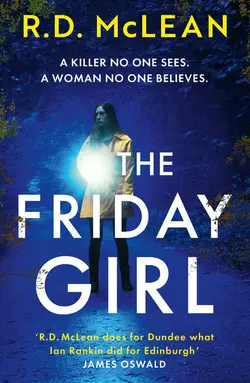The city of Dundee sits on the banks of the river Tay before it opens out into the North Sea. Once the city of jute, jam, and journalism, it’s now branded the City of Discovery, its fortunes having greatly improved since the millennium in terms of science and culture. But it’s not this modern Dundee that features in R.D McLean’s The Friday Girl (2025) – it’s a grittier incarnation; a city drowning in its post-industrial decline.
Detective Elizabeth Burnet is the titular Friday Girl. Having once done a newspaper feature in her police uniform (“Here’s a lass doing a job. Isn’t she pretty? See another one tomorrow.”) she’s the pin-up of the station. For a woman who “just wants to be polis”, it’s an awkward set-up at a time – the late 1970s – when sexism was rife and, if a woman was needed on a case it was “because someone’s got to make a cup of tea on this one!”. It’s likely no coincidence that this theme’s exploration is positioned the year before Margaret Thatcher would become the first woman to occupy the country’s highest attainable office.
But sexism isn’t the only rot in the Tayside Police: corruption is everywhere. Cops are on the take and investigations are mysteriously closed down. Burnet, with her hunches, is ignored and her partner in (solving) crime, Kelley, a second-generation copper, is convinced his late father may have secrets tucked away. All roads lead back to a local kingpin with enough sway to ensure the constabulary look the other way when crimes are afoot. And there’s certainly no shortage of misdeeds underway, whether that be a spate of robberies or the new wave of criminals being roughed up as Frank Gray, an ex-gangster once known as the Beast of Balgay, falls back into the game.
And what crime novel wouldn’t be without a killer on the loose? While it feels more secondary to the institutional concerns, it ties in with the wider story arc and doesn’t feel forced. Very loosely based on some unsolved crimes from Dundee’s past (the Templeton Woods murders) someone is out there killing people and with a calling card distinctive enough to earn the moniker ‘the Werewolf’. Being set in the 1970s, the investigation allows for some dramatic ironies (“What use was hair to anyone at a crime scene?”) and often sees a reliance more on feasibility and supposition than proper plodwork.
There’s a lot going on in The Friday Girl, all of it tightly plotted and delivered in a hardboiled style that feels frugal yet impressively distills people – their thoughts and movements – into just a few words. With the economy of Elmore Leonard and the dark grit of David Peace, McLean is wrapping his noir over Dundee. Though the clipped style captures its characters well, it leaves the city somewhat less memorable, functioning more as a catalogue of places rather than a fully-realised character. But as is noted, “There’s the official public-facing city, and then there’s something like a shadow city where the real world happens.” and it’s what happens in these darker spots that truly counts.
Burnet’s efforts to be taken seriously as a detective rather than a woman provide a key journey through The Friday Girl, while Kelley tackles his father’s record and the interplay of Gray’s family life and criminal past lead to unexpected struggles of conscience. While I’m not sure if Burnet is intended to be an ongoing character, she’s certainly put herself in a position of competence meaning future investigations may not see being a “bubbly” beauty as a barrier to police work. “Dundee creates strong women,” the story says, and McLean has one in The Friday Girl.
